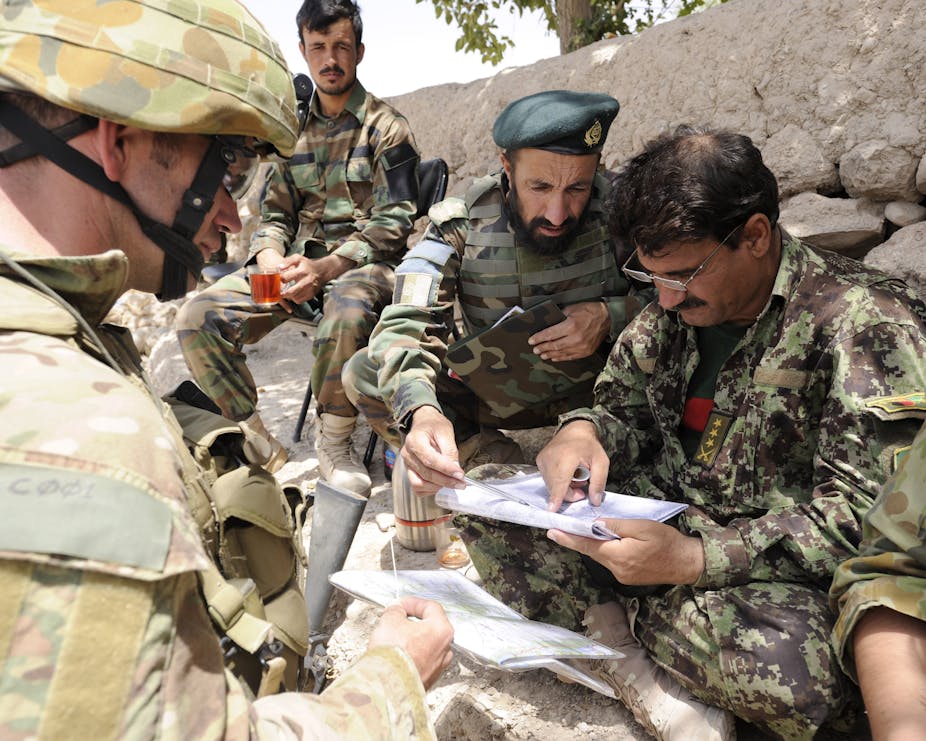Prime minister Julia Gillard today announced the revised timetable for the withdrawal of Australian troops from Afghanistan.
Within 12 to 18 months the majority of Australian military forces will leave Afghanistan, a year earlier than originally planned.
During the conflict, Australian forces have focused on training the Afghan National Army’s 4th Brigade in Uruzgan province. Gillard said there are encouraging signs that this force is increasingly capable of operating without Australian support.
But the opposition has suggested the timing of the withdrawal may reflect “domestic political convenience”, rather than sound military strategy.
The Conversation spoke with Garth Pratten from the ANU’s Strategic and Defence Studies Centre to discuss the motivations behind the withdrawal and its consequences.
Why is Australia withdrawing now?
Australia’s withdrawal from Afghanistan is in line with the timeline that was set down by International Security Assistance Force (ISAF) after the Lisbon conference. What’s happened since 2011 is a gradual transition in parts of the country from ISAF to Afghan leaders. That’s a four stage process – we’ve had tranche one and two already.
Australia’s involvement has always been very closely tied to Uruzgan province. This province is not insignificant but not as significant as Kandahar or the provinces along the border with Pakistan.
So it stands to reason that as ISAF works towards its 2014 timeline for transition, Uruzgan will be transferred to Afghan lead prior to some of the more important provinces in the south. This is likely to start in the next tranche, some time in 2013.
Now the prime minister has always maintained that Australia will maintain the course and today’s speech continues to commit force elements to ISAF up until 2014 and beyond.
But once Uruzgan is transferred, the Australian presence will be very much wound down. Most of our reconstruction and mentoring troops will come home.
Has the ADF achieved its objectives?
If you look in the broad strategic sense, the main reason we’re there is to support the US alliance. We have done that, we have contributed troops to part of the Afghan effort. So we have “succeeded” as far as this is concerned.
In terms of building a safer and more secure Uruzgan, we’re not going to know for some time.
Australia and its Afghan allies have developed areas of security within Uruzgan. A lot more areas are now under Afghan government control than they were. There are more students going to school, more facilities being built and better infrastructure, particularly roads. Whether this is a lasting effort with lasting effect remains to be seen.
These changes are all tied to security, and to the ability of the Afghan government to maintain its freedom of movement, as well as having the resources to maintain these services to the people.
But also there’s an argument that the moment security is an Afghan responsibility the Taliban will be resurgent, the Afghan government’s ability to govern will not be there and so it will go back to how it was.
And even if there is security there are questions about the government’s ability to deliver services. So have we achieved what we set out to do? It’s a very difficult question.
Australian troops have been training local forces to continue in Afghanistan – is this strategy likely to succeed?
If you look at the history of fighting insurgencies, most insurgencies that end up with a victory for the government need two things. First is the development of local capacity, in terms of security forces, and the other is some kind of negotiated settlement.

So if western forces wanted out of Afghanistan at any point in time what they needed to do was train up the Afghan national security forces to take over security and allow the government to govern.
Now if you look at overall NATO statistics and assessments of Afghan forces, there’s only one single army unit right throughout the Afghan National Army that is fit to conduct operations by itself. And there are no units of the Afghan National Police that are able to do it. They still require mentoring, training and support from NATO.
Now given that we’ve been in that training role for many years, the big question is how much can be achieved in the next year or so in Uruzgan.
And we can go back again to historical examples. If you look at the American withdrawal from South Vietnam, there was a major offensive in 1972, the south had American air power and combat support and they were able to push that offencive back.
Come 1975, the American withdrawal was complete, there was no support for the south Vietnamese and they were rolled by the north.
If you look at this week’s attacks on Kabul, by and large the Afghans dealt with the threat on the ground but they still have some NATO support.
But when I was in Afghanistan in 2010, Taliban insurgents seized a hotel building and essentially the Afghan security forces cordoned off the hotel and dealt with the problem.
So are they ready? Maybe not. Can they frustrate Taliban efforts? Yes, they can.
But we need to be realistic about this, that ultimately the security situation is not going to ever be what you would have in Sydney or Washington. The nature of Afghanistan means there’s always going to be guns and tribal tensions. But the priority is to have enough security for the government to function.

